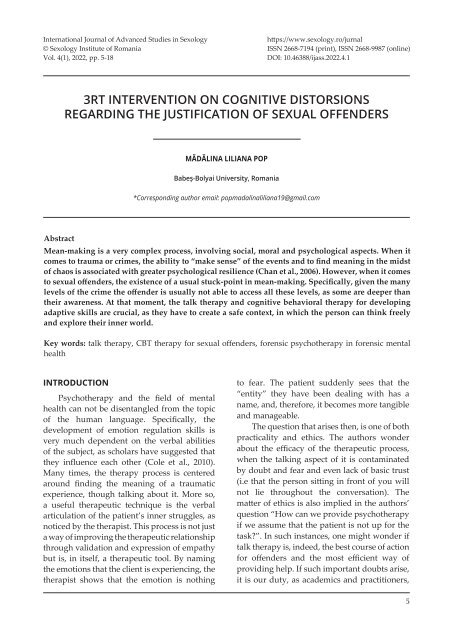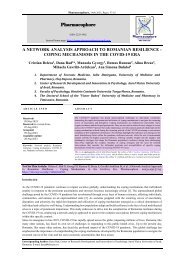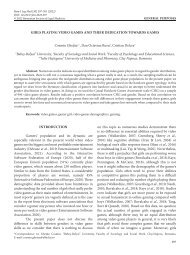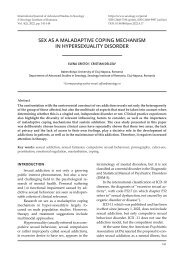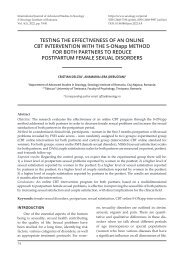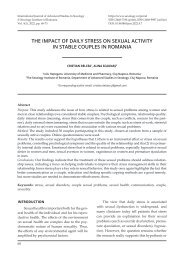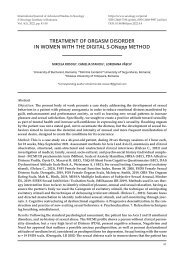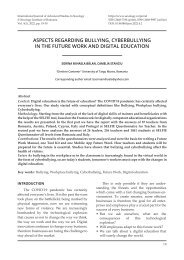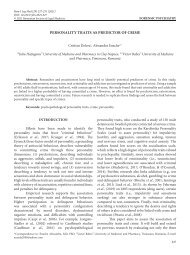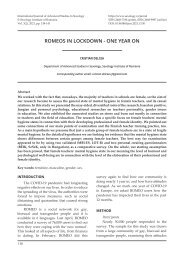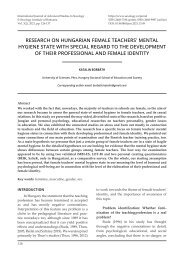3RT INTERVENTION ON COGNITIVE DISTORSIONS REGARDING THE JUSTIFICATION OF SEXUAL OFFENDERS
Mean-making is a very complex process, involving social, moral and psychological aspects. When it comes to trauma or crimes, the ability to “make sense” of the events and to find meaning in the midst of chaos is associated with greater psychological resilience (Chan et al., 2006). However, when it comes to sexual offenders, the existence of a usual stuck-point in mean-making. Specifically, given the many levels of the crime the offender is usually not able to access all these levels, as some are deeper than their awareness. At that moment, the talk therapy and cognitive behavioral therapy for developing adaptive skills are crucial, as they have to create a safe context, in which the person can think freely and explore their inner world.
Mean-making is a very complex process, involving social, moral and psychological aspects. When it
comes to trauma or crimes, the ability to “make sense” of the events and to find meaning in the midst
of chaos is associated with greater psychological resilience (Chan et al., 2006). However, when it comes
to sexual offenders, the existence of a usual stuck-point in mean-making. Specifically, given the many
levels of the crime the offender is usually not able to access all these levels, as some are deeper than
their awareness. At that moment, the talk therapy and cognitive behavioral therapy for developing
adaptive skills are crucial, as they have to create a safe context, in which the person can think freely
and explore their inner world.
- No tags were found...
Create successful ePaper yourself
Turn your PDF publications into a flip-book with our unique Google optimized e-Paper software.
International Journal of Advanced Studies in Sexology<br />
© Sexology Institute of Romania<br />
Vol. 4(1), 2022, pp. 5-18<br />
https://www.sexology.ro/jurnal<br />
ISSN 2668-7194 (print), ISSN 2668-9987 (online)<br />
DOI: 10.46388/ijass.2022.4.1<br />
<strong>3RT</strong> <strong>INTERVENTI<strong>ON</strong></strong> <strong>ON</strong> <strong>COGNITIVE</strong> DISTORSI<strong>ON</strong>S<br />
<strong>REGARDING</strong> <strong>THE</strong> JUSTIFICATI<strong>ON</strong> <strong>OF</strong> <strong>SEXUAL</strong> <strong>OF</strong>FENDERS<br />
MĂDĂLINA LILIANA POP<br />
Babeș-Bolyai University, Romania<br />
*Corresponding author email: popmadalinaliliana19@gmail.com<br />
Abstract<br />
Mean-making is a very complex process, involving social, moral and psychological aspects. When it<br />
comes to trauma or crimes, the ability to “make sense” of the events and to find meaning in the midst<br />
of chaos is associated with greater psychological resilience (Chan et al., 2006). However, when it comes<br />
to sexual offenders, the existence of a usual stuck-point in mean-making. Specifically, given the many<br />
levels of the crime the offender is usually not able to access all these levels, as some are deeper than<br />
their awareness. At that moment, the talk therapy and cognitive behavioral therapy for developing<br />
adaptive skills are crucial, as they have to create a safe context, in which the person can think freely<br />
and explore their inner world.<br />
Key words: talk therapy, CBT therapy for sexual offenders, forensic psychotherapy in forensic mental<br />
health<br />
INTRODUCTI<strong>ON</strong><br />
Psychotherapy and the field of mental<br />
health can not be disentangled from the topic<br />
of the human language. Specifically, the<br />
development of emotion regulation skills is<br />
very much dependent on the verbal abilities<br />
of the subject, as scholars have suggested that<br />
they influence each other (Cole et al., 2010).<br />
Many times, the therapy process is centered<br />
around finding the meaning of a traumatic<br />
experience, though talking about it. More so,<br />
a useful therapeutic technique is the verbal<br />
articulation of the patient’s inner struggles, as<br />
noticed by the therapist. This process is not just<br />
a way of improving the therapeutic relationship<br />
through validation and expression of empathy<br />
but is, in itself, a therapeutic tool. By naming<br />
the emotions that the client is experiencing, the<br />
therapist shows that the emotion is nothing<br />
to fear. The patient suddenly sees that the<br />
“entity” they have been dealing with has a<br />
name, and, therefore, it becomes more tangible<br />
and manageable.<br />
The question that arises then, is one of both<br />
practicality and ethics. The authors wonder<br />
about the efficacy of the therapeutic process,<br />
when the talking aspect of it is contaminated<br />
by doubt and fear and even lack of basic trust<br />
(i.e that the person sitting in front of you will<br />
not lie throughout the conversation). The<br />
matter of ethics is also implied in the authors’<br />
question “How can we provide psychotherapy<br />
if we assume that the patient is not up for the<br />
task?”. In such instances, one might wonder if<br />
talk therapy is, indeed, the best course of action<br />
for offenders and the most efficient way of<br />
providing help. If such important doubts arise,<br />
it is our duty, as academics and practitioners,<br />
5
MĂDĂLINA LILIANA POP<br />
to clarify the utility of those methods, before<br />
arguing in their favour.<br />
Theoretical approach<br />
The first part of Chapter 11 from Forensic<br />
Psychiatry and Psychology in Europe (Goethals,<br />
2018) deals with the aspect of language when<br />
it comes to Forensic psychotherapy. It is a<br />
well known fact that the outcome of therapy<br />
is dependent on the therapeutic relationship<br />
(Lambert & Barley, 2001). This relationship is<br />
based on mutual trust, as well as unconditional<br />
acceptance and the expression of empathy.<br />
When it comes to Forensic psychotherapy, the<br />
authors wonder how much of that relationship<br />
can be built through talking and how easily a<br />
therapist can develop trust when it comes to<br />
a patient that has committed crimes. Another<br />
issue that arises is how much an offender<br />
can trust the therapist, given their negative<br />
experiences with authorities and the possible<br />
consequences of admitting to the committed<br />
crimes. The topics addressed by offenders<br />
are often difficult for them to talk about. A<br />
phenomenon that may happen is the distortion of<br />
the events by the offender (i.e by minimizing the<br />
offence or by attributing more fault to the victim).<br />
In the anecdote presented by Koenraadt,<br />
McGauley, & Willemsen (2018), regarding<br />
the psychiatrist’s bias, the misunderstanding<br />
arises from the words chosen by the offender<br />
to describe his crime. When it comes to<br />
certain therapy protocols (i.e for treating Post<br />
Traumatic Stress - PTSD), an important aspect<br />
is the creation of a comprehensive, coherent<br />
and detailed narrative of the client’s life story<br />
or trauma. In exposure therapy for PTSD<br />
(Rauch & Foa, 2006), for example, the patient is<br />
required to retell the story of the trauma over<br />
and over, as well as to listen to tapes of them<br />
telling that story! The mechanism of change<br />
is the repeated exposure to those stimuli that<br />
once presented themselves as so horrifying<br />
that the client would not be able to face them.<br />
This exposure is facilitated by the “simple” act<br />
of talking. Many of our patients have never had<br />
anyone that they could openly talk to about<br />
their feelings, no one to help them sort their<br />
tangled ideas and make sense of them. Talking<br />
is, then, a curative process in many therapeutic<br />
instances. Let’s take coaching for example. We<br />
ask our clients to elaborate their goals, we ask<br />
them to specify their wishes and values in<br />
great detail, in order to create an action plan<br />
and a path to a satisfying life. The chapter’s<br />
authors mention the importance of stories and<br />
narratives in finding meaning and orienting<br />
ourselves in the world. The ability to make<br />
the inner world explicit is, therefore, a crucial<br />
element of psychotherapy.<br />
The use of narratives to create meaning<br />
is also used in Forensic psychotherapy. The<br />
stories told by offenders are closely linked to<br />
the issue of morality. When creating a story of<br />
the crime, the offender has to first think about<br />
what they did wrong and then analyse the<br />
causes and effects of that wrongdoing. In order<br />
for that to happen, moral judgment plays a central<br />
role. The authors suggest that the distortions in<br />
the stories of offenders (i.e. attributing blame<br />
to the victim, minimizing the crime) could be<br />
a phenomenon of cognitive nature, rather than<br />
assuming that this tendency is personalitybased.<br />
The authors imply that such distortions<br />
may represent a defense mechanism, as studies<br />
have shown that taking full responsibility<br />
for our dysfunctional behaviour could be<br />
detrimental to one’s mental health. In dealing<br />
with other kinds of issues brought by our<br />
clients (besides crimes), we often encourage<br />
them “to see the bigger picture” and to give up<br />
black-and-white thinking, in favor of a more<br />
nuanced way of viewing things. We rarely ask<br />
clients to take full responsibility for something<br />
that has happened to them, partly because<br />
that would be too much to tolerate! When it<br />
comes to offenders, by contrast, we want them<br />
to suddenly and quickly give up all defense<br />
mechanisms and fully accept their fault. That is<br />
very unlikely to happen. Talk therapy is useful<br />
in this area for analyzing moral problems and<br />
possible solutions from perspectives other<br />
than that of sex offenders, in order to replace<br />
attitudes and cognitive distortions about moral<br />
reasoning and justifications for crime.<br />
When considering the motives of the<br />
crimes, the authors suggest the crime needs to<br />
be understood in the context of the patient’s<br />
6
<strong>3RT</strong> intervention on cognitive distorsions regarding the justification of sexual offenders<br />
life and can not be untangled from it. Freud<br />
believed that human behaviour is motivated by<br />
two drives: the sexual drive and the aggressive<br />
drive. He believed that the fuel for behaviour<br />
is the wish to satisfy the sexual and aggressive<br />
instincts. which are, for the most part, repressed<br />
into the unconscious. However, these drives<br />
are embodied, in the sense that they are<br />
acted out in the world by the body. When it<br />
comes to offenders, these drives usually begin<br />
to manifest early on, as the person shows<br />
aggressive tendencies throughout their life.<br />
This culminates with the act of the crime. The<br />
authors claim that the moment of the crime is<br />
the moment when the repressed and hidden<br />
parts of the person express themselves clearly,<br />
surpassing the self-defence mechanisms that<br />
had repressed them. However, since aggressive<br />
and sex drives are usually unconscious, it is<br />
very difficult for the person to fully articulate<br />
the motive of their crime.<br />
Regarding the history of Forensic<br />
psychotherapy, the approach used to be very<br />
rigid, at least in the Netherlands, the authors<br />
suggest. That is until the Utrecht Dr. H. van<br />
der Hoeven hospital was created. The new<br />
approach was based on Maxwell Jones’ idea<br />
to practice psychotherapy in small groups.<br />
He encouraged the hospital “to work as a<br />
therapeutic community”. That is, a community<br />
that relies on open communication and shared<br />
leadership. Therefore, the stigma associated<br />
with being a patient is decreased. As time<br />
passed, more hospitals embraced this idea.<br />
The community, as a therapeutic instrument,<br />
fosters a sense of safety and encourages the<br />
patients to disclose their experience with the<br />
staff member and other patients. Using this<br />
approach allows the patient to interact with<br />
the demands of external reality and practice<br />
new behaviours in a safe setting (as opposed to<br />
being institutionalized). The hospital becomes<br />
a center for reintegration.<br />
Although cognitive-behavioural<br />
approaches are dominant in the field of Forensic<br />
psychotherapy, the psychoanalytic notion of<br />
the unconscious mind and its roles in the crime<br />
act adds another dimension, thus facilitating<br />
the understanding of the offence. The authors<br />
suggest that the inner worlds of forensic<br />
patients are often marked by fragmentation<br />
and lack of cohesiveness.<br />
Given the large number of sex offenders<br />
in criminal justice systems, the need to outline<br />
effective interventions to reduce the likelihood<br />
of sexual recidivism has been emphasized<br />
(Becker, Harris & Sales, 1993; Marshall, 2001;<br />
Pitherii, 1993). The meta-analysis by Losel and<br />
Schmucker (2008) emphasized the positive<br />
effect of psychological treatments in reducing<br />
sexual recidivism. This meta-analysis included<br />
69 studies (N = 22,181 sex offenders), comparing<br />
the recurrence rates of sex offenders who<br />
received treatment (N = 9,512) with those who<br />
did not receive such programs (N = 12,669).<br />
Also, the intervention programs based on<br />
cognitive behavioral therapy had the highest<br />
levels of efficiency compared to other types of<br />
psychosocial programs.<br />
The main purpose of cognitive-behavioral<br />
interventions for sex offenders is to replace<br />
maladaptive cognitions and deviant sexual<br />
behavior with maladaptive beliefs and prosocially<br />
oriented behaviors. In this sense, it<br />
also aims to acquire new skills and specific<br />
strategies for solving problems, improving<br />
social perspectives and managing emotional<br />
states (Yates et al., 2000; Becker & Murphy,<br />
1998; Marshall et al., 1999). Cognitive<br />
distortions are the main factor that favors<br />
the appearance of sexual aggression, because<br />
they allow to reduce the cognitive dissonance,<br />
to reduce the responsibility and the guilt felt<br />
towards the committed deed. Thus, the main<br />
mechanism behind deviant sexual behavior is<br />
the justifications for sexual crime (Nicholaichuk<br />
et al., 2000; Johnston, & Marshall, 1997). The<br />
main distortions identified in the case of<br />
sex offenders are attributing the guilt of the<br />
victim, minimizing the damage caused and<br />
rationalizing the sexual assault (Feild, 1978).<br />
The main purpose of therapy for sexual<br />
offenses is to reduce a person’s likelihood<br />
of re-engaging in such behavior. There is<br />
currently no “gold standard” for dealing with<br />
sex crimes. <strong>3RT</strong> (Recidivism Risk Reduction<br />
Therapy) describes a cognitive-behavioral<br />
approach focused on behavior in sexual crime<br />
7
MĂDĂLINA LILIANA POP<br />
(Wheeler & Covell, 2005, Wheeler, George, &<br />
Stephens, 2005a, Wheeler, George & Stoner,<br />
2005b). Regarding sexual offending behavior,<br />
dynamic risk factors appear to be associated<br />
with one of two broad categories: deviant<br />
sexual interests and antisocial orientation<br />
(Hanson & Morton-Bourgon, 2004; Hanson<br />
& Bussière, 1998;, Bakker, & Ward , 2002;<br />
Quinsey, Lalumiere, Rice, & Harris, 1995;<br />
Roberts, Doren, & Thornton, 2002). <strong>3RT</strong><br />
explicitly includes dynamic risk factors (DRF)<br />
as the dominant framework for the treatment<br />
of sexual offenses. Dynamic risk factors refer<br />
to those aspects of the client’s environment,<br />
lifestyle or personality that are statistically<br />
associated with an increased risk of recurrence<br />
and may change.<br />
The main objective of the research<br />
is to investigate the effectiveness of <strong>3RT</strong><br />
intervention on cognitive distorsions regarding<br />
the justification of sexual offenders.<br />
Hypotheses<br />
1. The experimental group that will benefit from<br />
the <strong>3RT</strong> intervention will have significantly<br />
lower scores of the victim’s guilt compared<br />
to the control group (waiting list).<br />
2. The experimental group that will benefit from<br />
the <strong>3RT</strong> intervention will have significantly<br />
lower scores of minimizing the harm caused<br />
to the victim compared to the control group<br />
(waiting list).<br />
3. The experimental group that will benefit<br />
from the <strong>3RT</strong> intervention will have<br />
significantly lower scores of rationalization<br />
of sexual assault compared to the control<br />
group (waiting list).<br />
Method<br />
Design<br />
The study design is an experimental one,<br />
being an efficiency study.<br />
Participants<br />
The criteria for including participants (N =<br />
64), according to Gpower, are the following: to<br />
be sex offenders in liberty, to be over 18 years<br />
old, to participate voluntarily. They will be<br />
randomized into two groups (the intervention<br />
group vs. the control group represented by the<br />
waiting list).<br />
Measures<br />
The measured variables (pre-intervention,<br />
post-intervention, follow-up) are the score of<br />
cognitive distortion regarding the attribution<br />
of the victim’s guilt, the score of cognitive<br />
distortion regarding the minimization of the<br />
caused damage and the score of cognitive<br />
distortion regarding the rationalization of<br />
sexual aggression.<br />
Attitudes Toward Rape Victims Scale<br />
(Ward, 1988) and the Burt Rape Scales (Burt,<br />
1980) will be used to measure the cognitive<br />
distortion score related to attributing the<br />
victim’s guilt, RAPE Scale(Bumby, 1996), and<br />
The Abel and Becker Cognitions Scale (Abel et<br />
al., 1984) will be used to measure the cognitive<br />
distortion score related to minimizing the<br />
damage caused and Rape Myth Acceptance<br />
Scale (Payne, Lonsway, 1999) and Justifications<br />
Scale of the Multiphasic Sex Inventory<br />
(Nichols & Molinder, 1984, 2000; VRS-SO:<br />
Wong & Olver, 2010) will be used to measure<br />
the score of cognitive distortion related to the<br />
rationalization of sexual assault.<br />
Procedure<br />
The experimental group will be given<br />
the intervention Recidivism Risk Reduction<br />
Therapy (Wheeler, George & Stoner, 2005)<br />
(<strong>3RT</strong>) for 9 months to reduce the number of<br />
cognitive distortions regarding the justification<br />
of sexual offenses. The control group will be<br />
represented by the waiting list for 9 months.<br />
Measurements of dependent variables will<br />
be recorded at the beginning and end of the<br />
intervention and follow-up at 6 months. For<br />
statistical analysis, unifactorial ANOVA with<br />
repeated measurements will be used.<br />
Description of <strong>3RT</strong> intervention:<br />
Recidivism Risk Reduction Therapy<br />
(Wheeler, George & Stoner, 2005) comprises<br />
three phases: (i) pre-treatment, (ii) treatment and<br />
(iii) post-treatment. The primary mechanism<br />
of change occurs during the treatment phase,<br />
while the pre- and post-treatment phases are<br />
designed to prepare for effective treatment and<br />
to develop strategies to prevent recurrence.<br />
The “pre-treatment” phase involves<br />
an assessment period in which the client’s<br />
characteristic dynamic risk factors are<br />
8
<strong>3RT</strong> intervention on cognitive distorsions regarding the justification of sexual offenders<br />
identified and conceptualized as a “cluster” of<br />
thoughts, emotions, problem behaviors, and<br />
these problem behaviors become the focus<br />
of therapeutic change. Once a client’s DRFs<br />
have been identified and conceptualized as<br />
problematic behaviors, the goal of the <strong>3RT</strong><br />
treatment phase is to teach clients how to replace<br />
their maladaptive thoughts and behaviors<br />
with adaptive thoughts and behaviors (skills<br />
training).<br />
1. Pre-treatment phase<br />
Before starting the intervention, all patients<br />
participate in the pre-treatment phase for about<br />
4-8 weeks. The objectives of the Pre-treatment<br />
phase are: (i) obtaining the client’s informed<br />
consent to participate in the treatment; (ii)<br />
identify the resources that should be allocated<br />
to each client based on the recidivism<br />
assessment; (iii) assessing customers’ dynamic<br />
risk and response needs; (iv) conceptualizing<br />
the history of customer crimes in the<br />
broader context of their global operation; (v)<br />
formulation of the language treatment plan (to<br />
address the specific strengths and limitations<br />
of each client); and (vi) motivating customers<br />
to content and process.<br />
Input evaluation<br />
Assessment of dynamic risk needs.<br />
Main purpose is identification of stable<br />
DRFs of customers. DRFs are used as a<br />
guiding conceptual framework for describing<br />
problematic client behavior and formulating<br />
treatment goals. There are numerous resources<br />
for assessing DRF associated with general<br />
criminal recidivism (e.g., service inventory<br />
level - revised: Andrews & Bonta, 1995;<br />
Psychopathology Checklist - revised, second<br />
edition: Hare, 2003; revised): American<br />
Association of Psychiatry, 2000, Scale of Risk<br />
of Violence (VRS): Wong & Gordon, 2001,<br />
IORNS: Miller, 2006) and Sexual Recidivism<br />
(S<strong>ON</strong>AR Hanson & Harris 2000b; 2007 and<br />
Acute-2007: Hanson, Harris, Scott and Helmus,<br />
2007; Multiphase sexual inventory: Nichols &<br />
Molinder, 1984, 2000; VRS-SO: Wong & Olver,<br />
2010). DRFs for recidivism of sexual offenses<br />
fall into one of two areas that are associated<br />
with “sexual deviance” and / or “antisocial<br />
behavior”. In <strong>3RT</strong> these two broad areas are<br />
called erotopathic risk needs and antisocial<br />
risk. Each of these areas contains subcategories<br />
that describe the types of thoughts, emotions,<br />
and problem behaviors that characterize that<br />
area. Each subcategory includes many factors,<br />
each of which can be conceptualized as DRF<br />
that can be targeted in treatment.<br />
The need for erotopathic risk refers to any<br />
thoughts, feelings, behaviors, and relationships<br />
that are associated with the client’s problematic,<br />
inappropriate, or otherwise maladaptive<br />
sexual / romantic relationships. The erotopathic<br />
domain is divided into three categories. The<br />
first deficits in sexual self-regulation include the<br />
risk needs related to the deficient expression of<br />
sexual impulses. The second lack of intimacy<br />
refers to the ability to form and maintain<br />
close and intimate relationships with sexual<br />
partners of the same age. The third attitude<br />
that supports the sexual crime is the one that<br />
excuses, allows or condemns such behavior,<br />
including justifications, rationalizations and<br />
minimizing the consequences of the crime.<br />
Orientation sessions<br />
<strong>3RT</strong> covers a wide range of topics to<br />
help clients understand what to expect from<br />
treatment and why treatment will be beneficial<br />
to them. The purpose of these groups is to<br />
help clients understand that treatment is not<br />
something that happens to them, but is a process<br />
in which they are active participants and<br />
collaborators. These explanations lead to the<br />
active involvement in the client’s therapeutic<br />
process, increasing the credibility of therapists<br />
and strengthening the therapeutic alliance.<br />
Topics in the guidance include: the history<br />
of sexual offenses treatment, an overview of<br />
dynamic risk factors, CBT and DBT.<br />
Orientation sessions can be conducted<br />
individually or in groups, depending<br />
on available resources and customer<br />
response needs. Because these groups are<br />
psychoeducational in nature and patients are<br />
not required to disclose personal information,<br />
guidance groups may be “mixed”; that is,<br />
two or more clients could be placed together<br />
9
MĂDĂLINA LILIANA POP<br />
in a target group, regardless of clinically<br />
significant differences in their history of crime,<br />
demographic characteristics, dynamic risk<br />
factors, etc.<br />
2. Treatment phase<br />
The treatment phase uses CBT interventions<br />
focused on the acquisition of skills and their<br />
generalization, in order to target dynamic<br />
risk factors. Dynamic risk factors are used in<br />
conceptualization and the main goal of the<br />
treatment phase is to eliminate them. In other<br />
words, by the end of the treatment phase,<br />
clients should have developed new ways of<br />
thinking and behaving that would be expected<br />
to mitigate the risk of repeating them in the<br />
future. The treatment phase includes two<br />
therapeutic modalities: skills training sessions<br />
and individual therapy sessions.<br />
Training skills in <strong>3RT</strong>: Conceptualizing<br />
DRF as skills deficits<br />
In some traditional approaches to the<br />
treatment of sexual offenses, emphasis has<br />
been placed (clearly) on attracting clients to<br />
stop exposing problematic thoughts, emotions<br />
and behaviors (eg, stop your deviant fantasies).<br />
In <strong>3RT</strong>, the goal of all treatment interventions is<br />
to reduce / eliminate problematic behavior and<br />
replace it with adaptive behavior. If the client<br />
does not learn and practice a new response,<br />
it is expected that his old behavior will recur,<br />
especially when the client is under pressure<br />
or a state of increased arousal (eg anger,<br />
sexual arousal). During the treatment phase,<br />
clients participate in two rounds of training in<br />
cognitive-behavioral skills (for European and<br />
antisocial needs). Each competency training<br />
round lasts approximately 6 months and is<br />
organized into four problem-solving skills<br />
training modules: (i) thoughts, (ii) emotions, (iii)<br />
behaviors and (iv) relationships. In this study,<br />
attention is paid to the pathophysiological<br />
needs, so there will be a single round of skills<br />
training. Similar to the orientation sessions<br />
provided in the Pre-Treatment phase, the skills<br />
training sessions are mostly didactic, and clients<br />
do not have to disclose personal information<br />
about their history. These sessions are practical<br />
psychoeducation rather than a therapy group.<br />
However, they are integrated into therapies, as<br />
these sessions are a vital aspect of facilitating<br />
prosocial change through modeling.<br />
To facilitate this boundary between<br />
individual therapy sessions and skills training<br />
sessions, it is very important that competency<br />
training sessions be as separate as possible<br />
from individual sessions. This separation<br />
can be accomplished in several ways, such as<br />
using a skill trainer who is not the individual<br />
therapist, holding competency sessions on a<br />
different day / time than individual sessions,<br />
or holding competency training sessions on<br />
a different day. room than the therapy office.<br />
Skills training sessions can be conducted in<br />
individual or group formats, depending on<br />
available resources. These should be “closed”<br />
groups, so that all members of the group start<br />
and finish each module together (because<br />
each session is based on what was covered<br />
in the previous session). The members of the<br />
new group could join an existing group at the<br />
beginning of each of the four modules. Training<br />
sessions can be led by a therapist, but if there<br />
are adequate resources, it is recommended that<br />
these sessions be organized by a skills coach (or,<br />
ideally, two competency trainers per group).<br />
5 or 6 weeks are allocated per module, which<br />
means that all four modules will be completed<br />
in about 6 months, assuming weekly sessions.<br />
Adapting DBT skills training for <strong>3RT</strong><br />
A useful set of skills training techniques<br />
are those provided in the Skills Training<br />
Manual for Dialectical Behavioral Therapy<br />
(DBT, Linehan, 1993). DBT has demonstrated<br />
empirical success in reducing the maladaptive<br />
behaviors of people with borderline personality<br />
disorder (Linehan et al., 1991), and with other<br />
clinical populations (Dimeff & Koerner, 2007).<br />
More recently, increased attention has been<br />
paid to the applicability of DBT skills to the<br />
treatment of sexual offending behavior (Hover,<br />
1999, Hover & Packard, 1998, 1999; Wheeler<br />
et al., 2005b). In addition, Quigley (2000) and<br />
Shingler (2004) provide a detailed analysis<br />
of the theoretical and practical compatibility<br />
between DBT treatment and sexual offenses.<br />
10
<strong>3RT</strong> intervention on cognitive distorsions regarding the justification of sexual offenders<br />
DBT models address treatment needs<br />
that are directly relevant to DRFs associated<br />
with sexual offending behavior, including<br />
problematic thoughts (“deviant” sexual<br />
fantasies, antisocial attitudes, attitudes that<br />
support sexual abuse, sexual rights) sex/<br />
arousal, loneliness, anger/hostility, suspicion/<br />
mistrust), problematic behavior (sexual<br />
dysregulation/hypersexuality, use of sex<br />
as a coping strategy, aggression/violence,<br />
impulsivity, antisocial behavior, substance<br />
abuse, unstable/parasitic lifestyle, breaking the<br />
rules) and problematic relationships (emotional<br />
identification with children, instability/lack of<br />
romantic relationships, intimacy deficits, social<br />
isolation, proximal relationships with peers<br />
with the same traits and lack of concern for<br />
others).<br />
Specifically, it is recommended that the<br />
first round (approximately 6 months) of skills<br />
training in <strong>3RT</strong> involve “standard” training in<br />
DBT skills, without mentioning in particular<br />
the specific treatment needs of sexual offenses.<br />
For clients who have difficulty discussing<br />
or openly admitting their deviant sexual<br />
behavior, or for clients who may be resistant<br />
to participating in sex-specific therapy, the<br />
motivational interview may be used to be<br />
willing to make changes in their lives, but<br />
not they are still ready to solve their specific<br />
needs. It can facilitate changes in attitudes or<br />
tolerance towards vulnerability, which allow a<br />
willingness to explore more directly and / or<br />
address issues specific to sexual deviance and<br />
risk needs.<br />
Sex-offense-specific skills training<br />
Despite its theoretical and practical<br />
compatibility with the needs of this population,<br />
DBT does not address some of the specific<br />
treatment needs of clients who have engaged<br />
in sexual offenses. For example, DBT does not<br />
specifically include interventions to manage<br />
problematic / antisocial sexual thoughts,<br />
emotions, and behaviors. Therefore, <strong>3RT</strong><br />
includes a skills training program that is based<br />
on DBT skills training, but specifically modified<br />
to meet customers’ dynamic risk needs. As<br />
previously described, erotopathic risk needs<br />
(i.e., maladaptive sexual / romantic behaviors)<br />
and ansocial risk needs (i.e. maladaptive social<br />
behaviors and lifestyle) form the foundation<br />
of skills training sessions. Thus, skills training<br />
sessions are taught through the Competence<br />
Handbook for Dialectical Behavior Therapy<br />
(Linehan, 1993), aided by additional teaching<br />
notes, discussion points, and activities<br />
specifically designed to address these types of<br />
dynamic risk factors. Clients can be assigned<br />
to one or both types of skills training sessions.<br />
<strong>3RT</strong>-E skills training sessions<br />
In erotopathic <strong>3RT</strong> (<strong>3RT</strong>-E) skills training<br />
sessions, clients learn arousal monitoring<br />
skills, reduce problematic thinking patterns,<br />
and replace these maladaptive thoughts<br />
and behaviors with more effective methods<br />
of self-monitoring and regulation. sexual.<br />
Clients develop skills to develop and maintain<br />
adaptive, satisfying intimate relationships<br />
with partners of similar age. (Hanson et al.,<br />
2007), the following stable erotopic dynamic<br />
factors were associated with an increased risk<br />
of sexual recurrence:<br />
• Deviant sexual interests (sexual interest<br />
in children, any paraphilic interest, sexual<br />
concern)<br />
• Deviant sexual preferences (any deviant<br />
sexual preference, sexual preference for<br />
children)<br />
• Lack of romantic partner (no relationship or<br />
history of unstable relationships)<br />
• Deficiencies of intimacy (loneliness/ social<br />
isolation, emotional identification with<br />
children, conflicts with intimate partners)<br />
• Attitudes that support sexual offenses<br />
(attitudes that support rape, attitudes that<br />
support sexual offenders, sexual rights)<br />
When conceptualized as deficits, we<br />
need to direct the client to develop skills to<br />
maintain satisfying and prosocial intimate /<br />
sexual relationships. The purpose of the <strong>3RT</strong>-E<br />
competency training groups is to help clients<br />
develop at least some of the skills described<br />
below. To improve sexual self-monitoring skills,<br />
participants learn skills to monitor their own<br />
arousal processes (sexual thoughts, subjective<br />
arousal, sensory perceptions and physical<br />
sensations) and objective perception of stimuli<br />
11
MĂDĂLINA LILIANA POP<br />
in their environment (description of sexual<br />
stimuli without interpretation or judgment).<br />
These skills are specifically designed to target<br />
maladaptive patterns of sexualized thoughts<br />
and behaviors that contribute to inappropriate<br />
sexual self-regulation of offenders and to<br />
replace them with more effective methods for<br />
sexual self-control.<br />
To improve their sexual/emotional<br />
regulation skills, participants learn skills to<br />
identify, label, monitor, and control their sexual<br />
impulses, as well as the emotions inherent in<br />
engaging in romantic relationships (jealousy,<br />
insecurity, mistrust, anger). Participants<br />
learn to monitor sexual arousal and other<br />
physiological reactions and then label them.<br />
They also learn to reduce their vulnerability<br />
to certain emotional states, including sexual<br />
arousal as desirable. To reduce the misuse of<br />
sexual thoughts and behaviors as a coping<br />
strategy, participants learn skills to identify<br />
their maladaptive sexual adaptation strategies<br />
and replace them with more effective coping<br />
techniques. In addition to developing skills for<br />
acute coping responses, <strong>3RT</strong>-E skills include a<br />
broader focus on how to reduce overall stress<br />
in the client’s life, by increasing the number of<br />
behaviors (non-harmful and non-sexual) that<br />
the client engages in. finds them enjoyable or<br />
rewards them in some other way. To diminish<br />
romantic/sexual relationships and their<br />
interactions, clients learn and practice the skills<br />
to engage in prosocial interactions and intimate<br />
relationships. Ideally, these skills directly<br />
target those skills needed to form and maintain<br />
healthy romantic relationships (dating, ending<br />
relationships, building intimacy, obtaining<br />
mutual consent). These skills are modeled and<br />
repeated in groups (in role-playing games)<br />
and in vivo (through home missions or group<br />
trips).<br />
<strong>3RT</strong>: Individual therapy sessions<br />
The purpose of individual therapy sessions<br />
is to provide clients with the opportunity<br />
to address their specific needs in terms of<br />
risk and to apply the skills they learn for<br />
their functioning (using weekly diary books,<br />
activity diaries). In addition, individual<br />
sessions provide a format for clients to address<br />
significant life events and crises as they occur<br />
(and conduct functional analysis of problem<br />
behavior) and opportunities for behavioral<br />
rehearsals and feedback (i.e., role-plays).<br />
A therapeutic activity/intervention that<br />
actually takes place during individual sessions<br />
is a functional analysis of a client’s problematic<br />
behavior. Specifically, the client can learn in<br />
depth the thoughts and emotions associated<br />
with their behavior and how each one interacts.<br />
This information is essential to help clients<br />
understand their own vulnerabilities and<br />
identify intervention needs.<br />
Another therapeutic activity that best suits<br />
individual sessions is the creation, assignment<br />
and subsequent review of home practice<br />
activities (activity journals). Each week, the<br />
therapist reviews what important competencies<br />
the client is focusing on and develops activities<br />
to increase the client’s opportunities to practice<br />
these skills between sessions. The activity is<br />
clearly explained to the client and is explicitly<br />
related to their treatment needs. Before<br />
concluding the session, the therapist and client<br />
engage in certain prevention issues to identify<br />
possible barriers to completing assignments<br />
and how they can be minimized or completely<br />
eliminated. Most importantly, therapists then<br />
review the client’s progress toward completing<br />
this activity in the next therapy session,<br />
while continuing to address any barriers to<br />
completing assignments and implementing /<br />
practicing skills outside of formal treatment<br />
sessions.<br />
An example of practicing home skills that<br />
therapists can assign each week is an activity<br />
card/journal. These are sheets that identify<br />
each day of the week and specific tasks to be<br />
recorded or documented daily. For example,<br />
therapists may ask clients to keep track of<br />
the skills they use each day, how they spend<br />
their time on an hourly basis, or to record<br />
the frequency of their sexual thoughts and<br />
behaviors (e.g., an “arousal diary”). The<br />
purpose of these journals should be clearly<br />
explained to the client and the journals should<br />
be reviewed with the client in the next session.<br />
For some clients, the purpose of keeping such<br />
12
<strong>3RT</strong> intervention on cognitive distorsions regarding the justification of sexual offenders<br />
records may be to help them develop a more<br />
accurate assessment of how often they engage<br />
in certain activities, while for other clients it is<br />
possible to increase responsibility for how they<br />
engage. I spend time. What is most important<br />
is that the therapeutic rationale for keeping the<br />
journal is clear to the client and that the journal<br />
is reviewed after it has been completed.<br />
3. Post-treatment phase<br />
In <strong>3RT</strong>, the post-treatment phase can be<br />
performed in the form of weekly individual<br />
sessions or in the form of facilitator-led groups<br />
(4 weeks). This stage may involve less time face<br />
to face with therapists. Community transition<br />
planning applies to clients participating<br />
in community treatment. This phase can<br />
integrate other adjuvant groups, services<br />
and interventions. The two main objectives<br />
of clients in the post-treatment phase are: (i)<br />
to finalize a PR Plan that includes their acute<br />
DRFs and (ii) to identify the basic logistical<br />
needs of the community (and / or away from<br />
professional support and supervision); and<br />
their Community transition plan to meet these<br />
needs (residential, employment, financial,<br />
social / emotional). Clients should be provided<br />
with sketches and guidelines for the completion<br />
of both the PR plan and the Community<br />
transition plan, and the differences between<br />
each plan should be clearly explained. Creating<br />
a routine and a structured day is a therapeutic<br />
instrument used with all kinds of patients,<br />
as it is well-known that having a purpose is<br />
associated with well-being (Reker, 1989).<br />
Outcomes<br />
Following the validation of the intervention<br />
in other studies (Wheeler & Covell, 2005;<br />
Wheeler, George, & Stephens, 2005a; Wheeler,<br />
George, & Stoner, 2005b, Tafrate & Mitchell,<br />
2013), a priori we expect that the experimental<br />
group that benefited of <strong>3RT</strong> intervention has<br />
significantly lower scores of victim attribution<br />
compared to the control group. We also expect<br />
that the experimental group that benefited from<br />
<strong>3RT</strong> intervention has significantly lower scores<br />
of minimizing harm to the victim compared to<br />
the control group, and that the experimental<br />
group that benefited from <strong>3RT</strong> intervention<br />
has significantly lower scores of rationalizing<br />
sexual assault. compared to the control group.<br />
Limits and future directions of research<br />
In the case of Recidivism Risk Reduction<br />
Therapy (Wheeler & Covell, 2005) with sexual<br />
offenses, the notion of completing treatment is<br />
complex, primarily because patients who will<br />
be released during the program will artificially<br />
stop treatment. Terms such as graduation and<br />
completion can be misleading, contributing<br />
to the false impression that therapy is like a<br />
“class” with a clear beginning and end and /<br />
or that there is a fixed and terminal nature of a<br />
client’s risk and ability / need to change so that<br />
they are no longer at risk of engaging in sexual<br />
behavior problems.<br />
Indeed, clients’ progress, their change,<br />
and the nature and extent of their individual<br />
risk needs vary and are influenced by their<br />
current circumstances. Consequently, we are<br />
aware that changes will continue to occur with<br />
clients and that they will encounter or create<br />
situations and circumstances that are risky for<br />
them, which may require a return to treatment.<br />
C<strong>ON</strong>CLUSI<strong>ON</strong>S<br />
When it comes to practice, an advantage<br />
of Forensic psychotherapy’s psychoanalytic<br />
influences is the fact that it provides a<br />
framework through which practitioners can<br />
better understand the offenders. By looking at<br />
the crimes through a psychoanalytic perspective<br />
and talk therapy for offenders perspective, the<br />
practitioner can help the patient understand<br />
the unconscious motives of the crime, as well<br />
as the way in which these unconscious drives<br />
shape and influence the environment around<br />
the offender.<br />
It is also known that cognitive behavioral<br />
therapy is the best scientifically validated<br />
therapeutic approach for inmates. <strong>3RT</strong> is a<br />
cognitive-behavioral approach to treating<br />
sexual crimes. <strong>3RT</strong> uses dynamic risk factors<br />
as an organizational framework for treatment<br />
planning and delivery and draws on existing<br />
CBT techniques, such as DBT skills, to target<br />
these risk factors. <strong>3RT</strong> is an extremely flexible<br />
approach, which can be easily adapted to the<br />
13
MĂDĂLINA LILIANA POP<br />
needs of clients, including adults and minors,<br />
men and women, in hospitals and outpatients.<br />
In this way, <strong>3RT</strong> offers therapists a direct and<br />
empirical approach derived to reduce the risk<br />
of recurrence in patients with a history of<br />
sexual offenses.<br />
BIBLIOGRAPHY<br />
1. American Psychiatric Association. (2000).<br />
Diagnostic and statistical manual of mental<br />
disorders (4th ed.,text revision). Washington,<br />
DC: American Psychiatric Association.<br />
2. Andrews, D. A., & Bonta, J. (1995). The Level of<br />
Service Inventory – Revised. Toronto, Canada:<br />
Multi-Health Systems.<br />
3. Andrews, D. A., Bonta, J., & Hoge, R. D. (1990).<br />
Classification for effective rehabilitation:<br />
Rediscovering psychology. Criminal Justice &<br />
Behavior, 17, 19–52.<br />
4. Andrews, D. A., Dowden, C., & Gendreau, P.<br />
(1999). Clinically relevant and psychologically<br />
informed approaches to reduced reoffending:<br />
A meta-analytic study of human service, risk,<br />
need, responsivity, and other concerns in justice<br />
contexts. Unpublished manuscript. Ottawa,<br />
<strong>ON</strong>: Carleton University.<br />
5. Beech A, Mann R. Recent developments in the<br />
assessment andtreatment of sexual offenders.<br />
In: McGuire J, editor. Offender rehabilitation<br />
and treatment: effective programmes and<br />
policies to reduce re-offending. Chichester:<br />
Wiley-Blackwell; 2002. p. 259<br />
6. Blasko, B. L., & Jeglic, E. L. (2016). Sexual<br />
offenders’ perceptions of the client-therapist<br />
relationship: The role of risk. Sexual Abuse, 28,<br />
271–290.Criminology, 57, 5–24.<br />
7. Chan, C. L., Chan, T. H., & Ng, S. M. (2006).<br />
The strength-focused and meaning-oriented<br />
approach to resilience and transformation<br />
(SMART) a body-mind-spirit approach to<br />
trauma management. Social Work in Health Care,<br />
43(2-3), 9-36.<br />
8. Cole, P. M., Armstrong, L. M., & Pemberton,<br />
C. K. (2010). The role of language in the<br />
development of emotion regulation. In S. D.<br />
Calkins & M. A. Bell (Eds.), Child development<br />
at the intersection of emotion and cognition (pp.<br />
59–77). American Psychological Association.<br />
https://doi.org/10.1037/12059-004<br />
9. Covell, C., & Wheeler, J. (2011). Application of<br />
the responsivity principle to treatment of sexual<br />
offense behavior. Journal of Forensic Psychology<br />
Practice, 11(1), 61–72.<br />
10. Delcea, C., Siserman C., (2021). The Emotional<br />
Impact of Covid-19 On Forensic Staff. Rom J<br />
Leg Med [29] 142-146 [2021]. DOI: 10.4323/<br />
rjlm.2021.142.<br />
11. Delcea C., Enache A., (2021). Personality Traits<br />
as Predictor of Crime. Rom J Leg Med [29] 2,<br />
227-231 [2021] DOI: 10.4323/rjlm.2021.227.<br />
12. Delcea C., Siserman C., 2020: Validation<br />
and Standardization of the Questionnaire<br />
for Evaluation of Paraphilic Disorders. Rom<br />
J Leg Med28(1)14-20(2020) DOI:10.4323/<br />
rjlm.2020.14Romanian Society of Legal<br />
Medicine.<br />
13. Dimeff, L. A., & Koerner, K. (2007). Dialectical<br />
behavior therapy in clinical practice: Applications<br />
across disorders and settings. New York:<br />
Guildford.<br />
14. Dowden, C., & Andrews, D. A. (1999a). What<br />
works for female offenders: A meta-analytic<br />
review.Crime and Delinquency, 45, 438–452.<br />
15. Dowden, C., & Andrews, D. A. (1999b). What<br />
works in young offender treatment: A metaanalysis.<br />
Forum on Corrections Research, 11(2),<br />
21–24.<br />
16. Dowden, C., & Andrews, D. A. (2000). Effective<br />
correctional treatment and violent reoffending:<br />
A meta-analysis. Canadian Journal of Criminology,<br />
42, 449–476.<br />
17. Dowden, C., & Andrews, D. A. (2003). Does<br />
family intervention work for delinquents?<br />
Results of a meta-analysis. Canadian Journal of<br />
Criminology and Criminal Justice, 45, 327−342.<br />
18. Duntley, J., & Shackelford, T. K. (Eds.).<br />
(2008). Evolutionary forensic psychology. Oxford<br />
University Press.<br />
19. Feild, H. S. (1978). Attitudes toward rape: A<br />
comparative analysis of police, rapists, crisis<br />
counselors, and citizens. Journal of Personality<br />
and Social Psychology, 36(2), 156.<br />
20. Figley, C. R. (1995). Compassion fatigue<br />
as secondary traumatic stress disorder: An<br />
overview. In C. R. Figley (Ed.), Compassion<br />
fatigue: Coping with secondary traumatic<br />
stress disorder in those who treat<br />
21. Friedlander, M. L., Escudero, V., &<br />
Heatherington, L. (2006). Therapy with<br />
unwilling and mandated clients. In M. L.<br />
Friedlander, V. Escudero, & L. Heatherington<br />
(Eds.), Therapeutic alliances in couple and<br />
family therapy: An empirically informed guide<br />
14
<strong>3RT</strong> intervention on cognitive distorsions regarding the justification of sexual offenders<br />
to practice (pp. 197–210). Washington, DC:<br />
American Psychological Association;<br />
22. Goethals, K. (Ed.). (2018). Forensic psychiatry and<br />
psychology in Europe: A cross-border study guide.<br />
Springer.<br />
23. Hanson RK, Morton-Bourgon KE. The<br />
characteristics of persistent sexual offenders: a<br />
meta-analysis of recidivism studies. J Consult<br />
Clin Psychol. 2005;73:1154–63.<br />
24. Hanson, R. K. (2000). What is so special about<br />
relapse prevention? In D. R. Laws, S. M.<br />
Hudson, &<br />
25. Hanson, R. K., & Bussière, M. T. (1998).<br />
Predicting relapse: A meta-analysis of sexual<br />
offender recidivism studies. Journal of Consulting<br />
and Clinical Psychology, 66, 348–362.<br />
26. Hanson, R. K., & Harris, A. J. R. (2000). Where<br />
should we intervene? Dynamic predictors of<br />
sexual offense recidivism. Criminal Justice &<br />
Behavior, 27(1), 6–35.<br />
27. Hanson, R. K., & Harris, A. J. R. (2000b). The<br />
Sex Offender Need Assessment Rating (S<strong>ON</strong>AR):<br />
A method for measuring change in risk levels (User<br />
Report 2000–01). Ottawa: Public Safety and<br />
Emergency Preparedness Canada.<br />
28. Hanson, R. K., & Harris, A. J. R. (2001). A<br />
structured approach to evaluating change in<br />
risk levels. Sexual Abuse: A Journal of Research<br />
and Treatment, 13 (3), 105–122.<br />
29. Hanson, R. K., & Morton-Bourgon, K. (2004).<br />
Predictors of sexual recidivism: An updated metaanalysis<br />
(User Report 2004-02). Ottawa: Public<br />
Safety and Emergency Preparedness Canada.<br />
Retrieved from http://www.publicsafety.gc.ca/<br />
res/cor/rep/_fl/2004-02-pred-se-eng.pdf<br />
30. Hanson, R. K., & Yates, P. M. (2013). Psychological<br />
treatment of sex offenders. Current Psychiatry<br />
Reports, 15(3), 348.<br />
31. Hanson, R. K., Bourgon, G., Helmus, L., &<br />
Hodgson, S. (2009). The principles of effective<br />
correctional treatment also apply to sexual<br />
offenders: A meta-analysis. Criminal Justice and<br />
behavior, 36(9), 865-891.<br />
32. Hanson, R. K., Bourgon, G., Helmus, L., &<br />
Hodgson, S. (2009). The principles of effective<br />
correctional treatment also apply to sexual<br />
offenders: A meta-analysis. Criminal Justice &<br />
Behavior, 36,865–890.<br />
33. Hanson, R. K., Gordon, A., Harris, A. J. R.,<br />
Marques, J. K., Murphy, W., Quinsey, V. L.,<br />
et al. (2002). First report of the Collaborative<br />
Outcome Data Project on the effectiveness of<br />
psychological treatment of sex offenders. Sexual<br />
Abuse: A Journal of Research and Treatment, 14,<br />
169-194.<br />
34. Hanson, R. K., Harris, A. J. R, Scott, T-L., &<br />
Helmus, L. (2007). Assessing the risk of sexual<br />
offenders on community supervision: The Dynamic<br />
Supervision Project. Retrieved from http://www.<br />
publicsafety. gc.ca/res/cor/rep/_fl/crp2007-05-<br />
en.pdf<br />
35. Hanvey, S., Philpot, T., & Wilson, C. (2011). A<br />
community-based approach to the reduction of sexual<br />
re-offending: circles of support and accountability.<br />
London and Philadelphia: Jessica Kingsley<br />
Publishers.<br />
36. Hare, R. D. (2003). The Hare Psychopathy<br />
Checklist-Revised: Second Edition. Toronto: Multi-<br />
Health Systems.<br />
37. Harkins, L., & Beech, A.R. (2007). A review of<br />
the factors that can influence the effectiveness<br />
of sexual offender treatment: Risk, need,<br />
responsivity, and process issues. Aggression<br />
and Violent Behavior,12 (6), 615–627<br />
38. Hatcher, R., & Noakes, S. (2010). Working<br />
with sex offenders: The impact on Australian<br />
treatment providers. Psychology, Crime &<br />
Law, 16, 145–167.<br />
39. Hover, G. R. (1999). Using DBT skills with<br />
incarcerated sex offenders. ATSA Forum, 11 (3).<br />
40. Hover, G. R., & Packard, R. L. (1998, October).<br />
The effects of skills training on incarcerated<br />
sex offenders and their ability to get along with<br />
their therapist. Poster presented at the 17th<br />
Annual Research and Treatment Conference<br />
of the Association for the Treatment of Sexual<br />
Abusers, Vancouver, British Columbia.<br />
41. Hover, G. R., & Packard, R. L. (1999, September).<br />
The treatment effects of dialectical behavior therapy<br />
with sex offenders. Paper presented at the 18th<br />
Annual Research and Treatment Conference<br />
of the Association for the Treatment of Sexual<br />
Abusers, Lake Buena Vista, FL.<br />
42. Hudson, S. M., Ward, T., & Marshall, W. L.<br />
(1992). The abstinence violation effect in sex<br />
offenders: A reformulation. Behavior Research<br />
and Therapy, 30 (5), 435–441.<br />
43. Hudson, S.M., Wales, D.S., Bakker, L., & Ward,<br />
T. (2002). Dynamic risk factors: The Kia Marama<br />
evaluation. Sexual Abuse: A Journal of Research<br />
and Treatment, 14 (2), 103–119.<br />
44. In G. A. Marlatt & D. M. Donavan (Eds.), Relapse<br />
prevention (2nd ed., pp. 333–362). New York:<br />
Guilford Publications.<br />
45. Kennedy, S. M. (2000). Treatment responsivity:<br />
Reducing recidivism by enhancing treatment<br />
15
MĂDĂLINA LILIANA POP<br />
effectiveness. Forum on Corrections Research, 12,<br />
19–23.<br />
46. Kenworthy, T., Adams, C. E., Brooks-Gordon, B.,<br />
& Fenton, M. (2004). Psychological interventions<br />
for those who have sexually offended or are at risk<br />
of offending (CD004858; Cochrane Database of<br />
Systematic Reviews, Issue 3). Chichester, UK:<br />
John Wiley & Sons.<br />
47. Lambert, M. J., & Barley, D. E. (2001). Research<br />
summary on the therapeutic relationship and<br />
psychotherapy outcome. Psychotherapy: Theory,<br />
Research, Practice, Training, 38(4), 357–361.<br />
https://doi.org/10.1037/0033-3204.38.4.357<br />
48. Langevin, R. (2006). Acceptance and completion<br />
of treatment among sex offenders. International<br />
Journal of Offender Therapy and Comparative<br />
Criminology, 50(4), 402–417.<br />
49. Laws, D. R. (1995). Central elements in relapse<br />
prevention procedures with sex offenders.<br />
Psychology, Crime, & Law, 2, 41–53.<br />
50. Laws, D. R. (2003). The rise and fall of relapse<br />
prevention. Australian Psychologist, 38 (1), 22–30.<br />
51. Laws, D. R., Hudson, S. M., & Ward, T. (2000a).<br />
The original model of relapse prevention with<br />
sex offenders. In D. R. Laws, S.M. Hudson, &<br />
T. Ward (Eds.), Remaking relapse prevention with<br />
sex offenders: A sourcebook (pp. 2–24). New York:<br />
Guilford Press.<br />
52. Laws, D. R., Hudson, S. M., & Ward, T. (2000b)<br />
Remaking relapse prevention with sex offenders: A<br />
sourcebook. Thousand Oaks, CA: Sage.<br />
53. Linehan, M. M. (1993). Skills training manual for<br />
treating borderline personality disorder. New York:<br />
Guilford.<br />
54. Linehan, M. M., Armstrong, H. E., Suarez,<br />
A., Allmon, D., & Heard, H. L. (1991).<br />
Cognitive-behavioral treatment of chronically<br />
parasuicidal borderline patients. Archives of<br />
General Psychiatry, 48, 1060–1064.<br />
55. Lipton, D.S., Martinson, R., & Wilks, J. (1975).<br />
The effectiveness of correctional treatment: A<br />
survey of treatment evaluation studies. New York:<br />
Praeger.<br />
56. Lo¨sel, F. (2000). The efficacy of sexual offender<br />
treatment: A brief review of German and<br />
international evaluations. In P. J. van Koppen<br />
& N. Roos (Eds.), Rationality, information and<br />
progress in law and psychology. In honour of<br />
Hans Crombag (pp. 145Y170). Maastricht, NL:<br />
Metajuridica Publications.<br />
57. Looman, J., Dickie, I., & Abracen. J. (2005).<br />
Responsivity issues in the treatment of sexual<br />
offenders. Trauma, Violence, and Abuse, 6 (4),<br />
330–353.<br />
58. Lösel, F., & Schmucker, M. (2005). The<br />
effectiveness of treatment for sexual offenders:<br />
A comprehensive meta-analysis. Journal of<br />
Experimental Criminology, 1, 117-146.<br />
59. Marlatt, G. A. (1989). Feeding the PIG: The<br />
Problem of Immediate Gratification. In D.R.<br />
Laws (Ed.), Relapse prevention with sex offenders<br />
(pp. 56–21). New York: Guilford.<br />
60. Marlatt, G. A., & George, W. H. (1984). Relapse<br />
prevention: Introduction and overview of the<br />
model. British Journal of Addictions, 79, 261–273.<br />
61. Marlatt, G. A., & Gordon, J. R. (1985). Relapse<br />
prevention: Maintenance strategies in the treatment<br />
of addictive behavior. New York: Guilford Press.<br />
62. Marques, J. K., Wiederanders, M., Day, D. M.,<br />
Nelson, C., & Van Ommeren, A. (2005). Effects<br />
of a relapse prevention program on sexual<br />
recidivism: final results from California’s Sex<br />
Offender Treatment and Evaluation Project<br />
(SOTEP). Sexual Abuse: A Journal of Research and<br />
Treatment, 17 (1), 79–107.<br />
63. Marshall, W. L. (1996). Assessment,<br />
treatment and theorizing about sex offenders:<br />
Developments during the past twenty years and<br />
future directions. Criminal Justice and Behaviour,<br />
23, 162-199.<br />
64. Marshall, W. L., Fernandez, Y. M., Serran, G.<br />
A., Mulloy, R., Thornton, D., Mann, R. E., &<br />
Anderson, D. (2003). Process variables in the<br />
treatment of sexual offenders: A review of the<br />
relevant literature. Aggression and Violent<br />
Behavior, 8(2), 205–234.<br />
65. Marshall, W. L., Ward, T., Mann, R. E.,<br />
Moulden, H., Fernandez, Y. M., Serran, G., &<br />
Marshall, L. E. (2005). Working positively with<br />
sexual offenders: Maximizing the effectiveness<br />
of treatment. Journal of Interpersonal Violence, 20,<br />
1096–1114.<br />
66. Martinson, R. (1974). What works? Questions<br />
and answers about prison reform. The Public<br />
Interest, pp. 22–54.<br />
67. Miller, H. (2006). A dynamic assessment of<br />
offender risk, needs, and strengths in a sample<br />
of pre-release general offenders. Behavioral<br />
Sciences and the Law, 24, 767–782.<br />
68. Moulden, H. M., & Firestone, P. (2007). Vicarious<br />
traumatization: The impact on therapists who<br />
work with sexual offenders. Trauma, Violence,<br />
& Abuse, 8, 67–83.<br />
69. Moulden, H. M., & Firestone, P. (2010).<br />
Therapist awareness and responsibility in<br />
16
<strong>3RT</strong> intervention on cognitive distorsions regarding the justification of sexual offenders<br />
working with sexual offenders. Sexual Abuse: A<br />
Journal of Research and Treatment, 22, 374-386.<br />
70. Newring, K. A. B., Loverich, T. M., Harris, C. D.,<br />
& Wheeler, J. G. (2009). Relapse prevention. In<br />
W. T. O’ Donohue & J. E. Fisher (Eds.), General<br />
principles and empirically supported techniques of<br />
cognitive behavior therapy: Applying empirically<br />
supported techniques in your practice (2nd ed.),<br />
(pp. 520–531). Hoboken, NJ: John Wiley & Sons,<br />
Inc.<br />
71. Nichols, H. R., & Molinder, I. (1984). The<br />
Multiphasic Sex Inventory manual. Available<br />
from: Nichols and Molinder, 437 Bowes Drive,<br />
Tacoma, WA 98466, USA.<br />
72. Nichols, H. R., & Molinder, I. (2000). The<br />
Multiphasic Sex Inventory-II manual. Available<br />
from: Nichols and Molinder, 437 Bowes Drive,<br />
Tacoma, WA 98466, USA.<br />
73. Pithers, W. D., Marques, J. K., Gibat, C. C., &<br />
Marlatt, G. A. (1983). Relapse prevention with<br />
sexual aggressives: A self-control model of<br />
treatment and maintenance of change. In J. G.<br />
Greer & I. R. Stuart (Eds.), The sexual aggressor<br />
(pp. 124–239). New York: Van Nostrand<br />
Reinhold.<br />
74. Polaschek, D. L., & Ross, E. C. (2010). Do early<br />
therapeutic alliance, motivation, and stages<br />
of change predict therapy change for highrisk,<br />
psychopathic violent prisoners? Criminal<br />
Behaviour and Mental Health, 20, 100–111<br />
75. Quigley, S. M. (2000). Dialectical behavioral<br />
therapy and sex offender treatment: An<br />
integrative model. Dissertation Abstracts<br />
International, 60 (9), 4904B.<br />
76. Quinsey, V. L., Lalumiere, M. L., Rice, M. E., &<br />
Harris, G. T. (1995). Predicting sexual offenses.<br />
In J. C. Campbell (Ed.), Assessing dangerousness:<br />
Violence by sexual offenders, batterers, and child<br />
abusers (pp. 114–137). Thousand Oaks, CA:<br />
Sage.<br />
77. Rauch, S., & Foa, E. (2006). Emotional processing<br />
theory (EPT) and exposure therapy for PTSD.<br />
Journal of Contemporary Psychotherapy, 36(2), 61-<br />
65.<br />
78. Reker, G. T., Peacock, E. J., & Wong, P. T. (1987).<br />
Meaning and purpose in life and well-being:<br />
A life-span perspective. Journal of gerontology,<br />
42(1), 44-49.<br />
79. Rice, M. E., & Harris, G. T. (2003). The size and<br />
sign of treatment effects in sex offender therapy.<br />
Annals of the New York Academy of Sciences, 989,<br />
428-440.<br />
80. Roberts, C. F., Doren, D. M., & Thornton, D.<br />
(2002). Dimensions associated with assessments<br />
of sexoffender recidivism risk. Criminal Justice<br />
and Behavior, 29, 569–589.<br />
81. Sabin-Farrell, R., & Turpin, G. (2003). Vicarious<br />
traumatization: Implications for the mental<br />
health of health workers? Clinical Psychology<br />
Review, 23, 449–480.<br />
82. Serran, G. A., & Marshall, W. L. (2010).<br />
Therapeutic process in the treatment of sexual<br />
offenders: A review article. The British Journal<br />
of Forensic Practice, 12(3), 4–16.<br />
83. Serran, G. A., Fernandez, Y., Marshall, W. L., &<br />
Mann, R. E. (2003). Process issues in treatment:<br />
Application to sexual offender programs.<br />
Professional Psychology: Research and Practice,<br />
34(4), 368–374.<br />
84. Severson, M., & Pettus-Davis, C. (2013).<br />
Parole officers’ experiences of the symptoms<br />
of secondary trauma in the supervision of sex<br />
offenders. International Journal of Offender<br />
Therapy and Comparative<br />
85. Shingler, J. (2004). A process of crossfertilization:<br />
What sex offender treatment can<br />
learn from dialectical behavior therapy. Journal<br />
of Sexual Aggression, 10 (2), 171–180.<br />
86. Stoner, S. A., & George, W. H. (2000). Relapse<br />
prevention and harm reduction: Areas of<br />
overlap. In D. R. Laws, S.M. Hudson, & T.<br />
Ward (Eds.), Remaking relapse prevention with<br />
sex offenders: A sourcebook (pp. 56–75). Thousand<br />
Oaks, CA: Sage.<br />
87. T. Ward (Eds.), Remaking relapse prevention with<br />
sex offenders: A sourcebook (pp. 27–38). Thousand<br />
Oaks, CA: Sage.<br />
88. Tafrate, R. C., & Mitchell, D. (Eds.). (2013).<br />
Forensic CBT: A handbook for clinical practice.<br />
John Wiley & Sons.<br />
89. Tatman, A. W., & Love, K. (2010). An offender<br />
version of the working alliance inventory-short<br />
revised. Journal of Offender Rehabilitation, 49,<br />
165–179 the traumatized (pp. 1–20). New York,<br />
NY: Brunner/Mazel.<br />
90. Ward, T. & Hudson, S.M. (2000). A selfregulation<br />
model of relapse prevention. In D. R.<br />
Laws, S. M. Hudson, & T. Ward (Eds.), Remaking<br />
relapse prevention with sex offenders: A sourcebook<br />
(pp. 79–101). New York: Guilford Press.<br />
91. Ward, T., & Hudson, S. M. (1996a). Relapse<br />
prevention: A critical analysis. Sexual Abuse: A<br />
Journal of Research and Treatment, 8, 177–200.<br />
17
MĂDĂLINA LILIANA POP<br />
92. Ward, T., & Hudson, S. M. (1996b). Relapse<br />
prevention: Future directions. Sexual Abuse: A<br />
Journal of Research and Treatment, 8, 249–256.<br />
93. Ward, T., & Hudson, S. M. (1998). A model of<br />
the relapse process in sexual offenders. Journal<br />
of Interpersonal Violence, 13, 700–725.<br />
94. Ward, T., & Marshall, W. L. (2004). Good lives,<br />
aetiology and the rehabilitation of sex offenders:<br />
A bridging theory. Journal of Sexual Aggression,<br />
10, 153–169.<br />
95. Ward, T., Louden, K., Hudson, S. M., & Marshall,<br />
W. L. (1995). A descriptive model of the offense<br />
chain for child molesters. Journal of Interpersonal<br />
Violence, 10, 452–472.<br />
96. Ward, T., Melser, J., & Yates, P. (2007).<br />
Reconstructing the Risk-Need-Responsivity<br />
model: A theoretical elaboration and evaluation.<br />
Aggression and Violent Behavior, 12, 208–228.<br />
97. Way, I., VanDeusen, K. M., Martin, G.,<br />
Applegate, B., & Jandle, D. (2004). Vicarious<br />
trauma: A comparison of clinicians who treat<br />
survivors of sexual abuse and sexual offenders.<br />
Journal of Interpersonal Violence, 19, 49–71.<br />
98. Wheeler, J. G. (2003). The abstinence violation<br />
effect in a sample of incarcerated sexual<br />
offenders: A reconsideration of the terms lapse<br />
and relapse. Dissertation Abstracts International,<br />
63 (8), 3946B.<br />
99. Wheeler, J. G., & Covell, C. (2005). Stable dynamic<br />
risk-need rating manual: For treatment planning,<br />
delivery, and progress evaluation. Unpublished<br />
manual.<br />
100. Wheeler, J. G., George, W. H., & Marlatt, G. A.<br />
(2006). Relapse prevention for sexual offenders:<br />
Considerations for the Abstinence Violation<br />
Effect. Sexual Abuse: Journal of Research and<br />
Treatment, 18 (3), 233–248.<br />
101. Wheeler, J. G., George, W. H., & Stephens, K.<br />
(2005a). Assessment of sexual offenders: A<br />
model for integrating dynamic risk assessment<br />
and relapse prevention approaches. In D. M.<br />
Donavan & G. Marlatt (Eds.), Assessment of<br />
addictive behaviors (2nd ed., pp. 392–424). New<br />
York: Guilford Publications.<br />
102. Wheeler, J. G., George, W. H., & Stoner, S. A.<br />
(2005b). Enhancing the relapse prevention<br />
model for sex offenders: Adding recidivism risk<br />
reduction therapy (<strong>3RT</strong>) to target offenders’<br />
dynamic risk needs.<br />
103. Wilson, R. J., & Prinzo, M. (2001). ‘Circles of<br />
support: A restorative justice initiative.’ Journal<br />
of Psychology and Human Sexuality, 13, 59–77.<br />
104. Wilson, R. J., McWhinnie, A., Picheca, J.<br />
E., Prinzo, M., & Cortoni, F. (2007). Circles<br />
of support and accountability: Engaging<br />
community volunteers in the management of<br />
high-risk sexual offenders. The Howard Journal<br />
of Criminal Justice, 46, 1–15.<br />
105. Wong, S. C. P., & Gordon, A. (2001). The<br />
Violence Risk Scale. Bulletin of the International<br />
Society for Research on Aggression, 23 (2), 16–20.<br />
106. Wong, S. C. P., & Olver, M. E. (2010). The<br />
Violence Risk Scale and the Violence Risk Scale-<br />
Sex Offender Version. In R. Otto & K. Douglas<br />
(Eds.), Handbook of violence risk assessment. New<br />
York: Routledge.<br />
18


